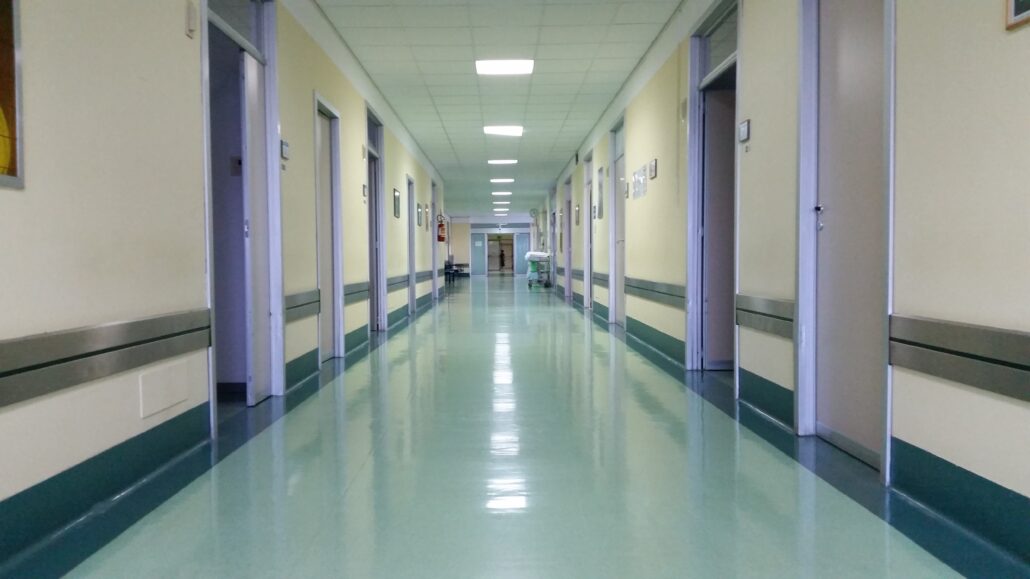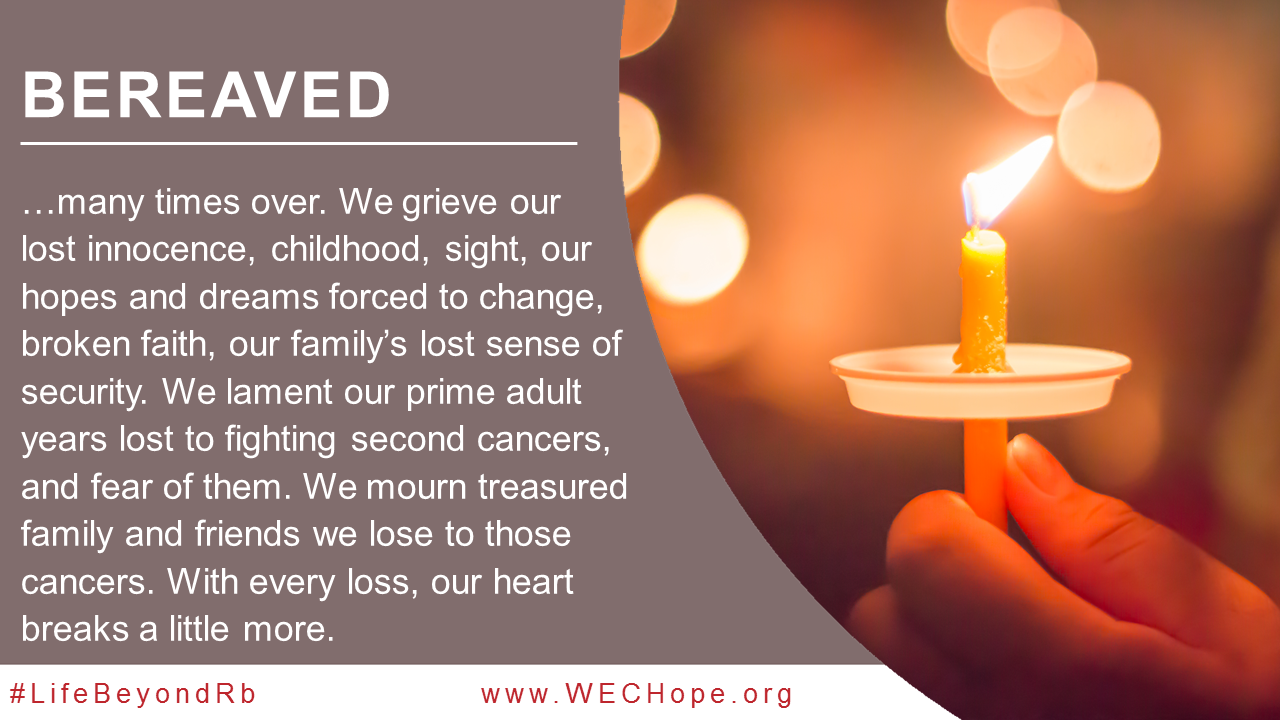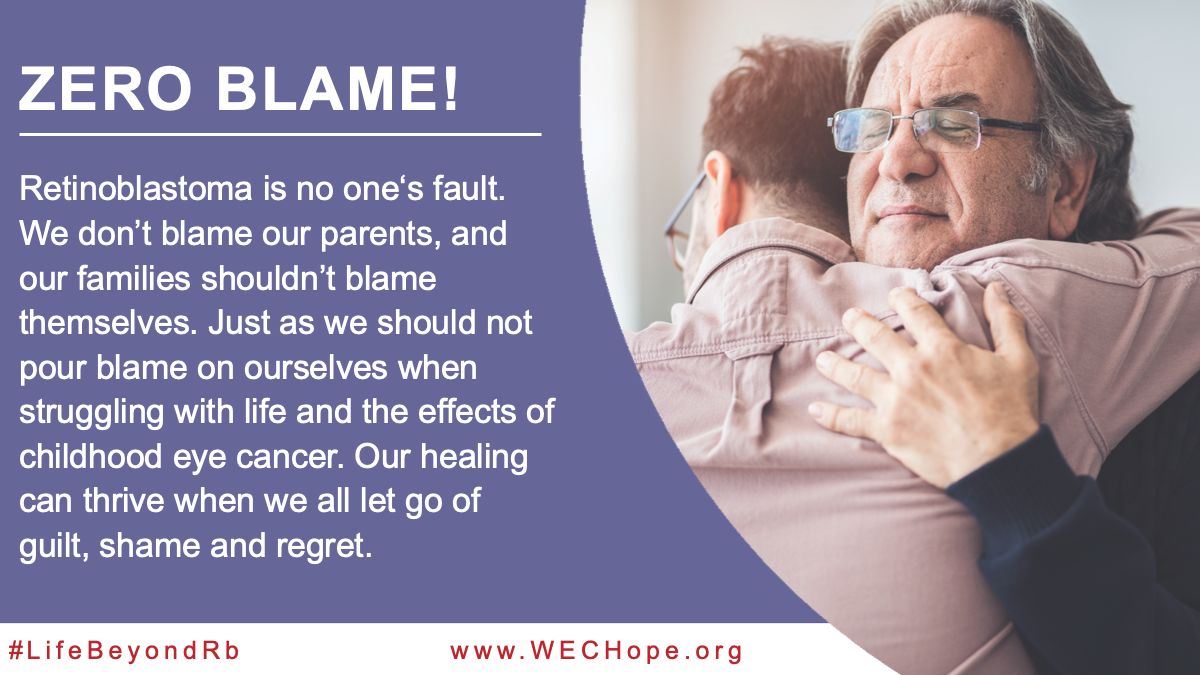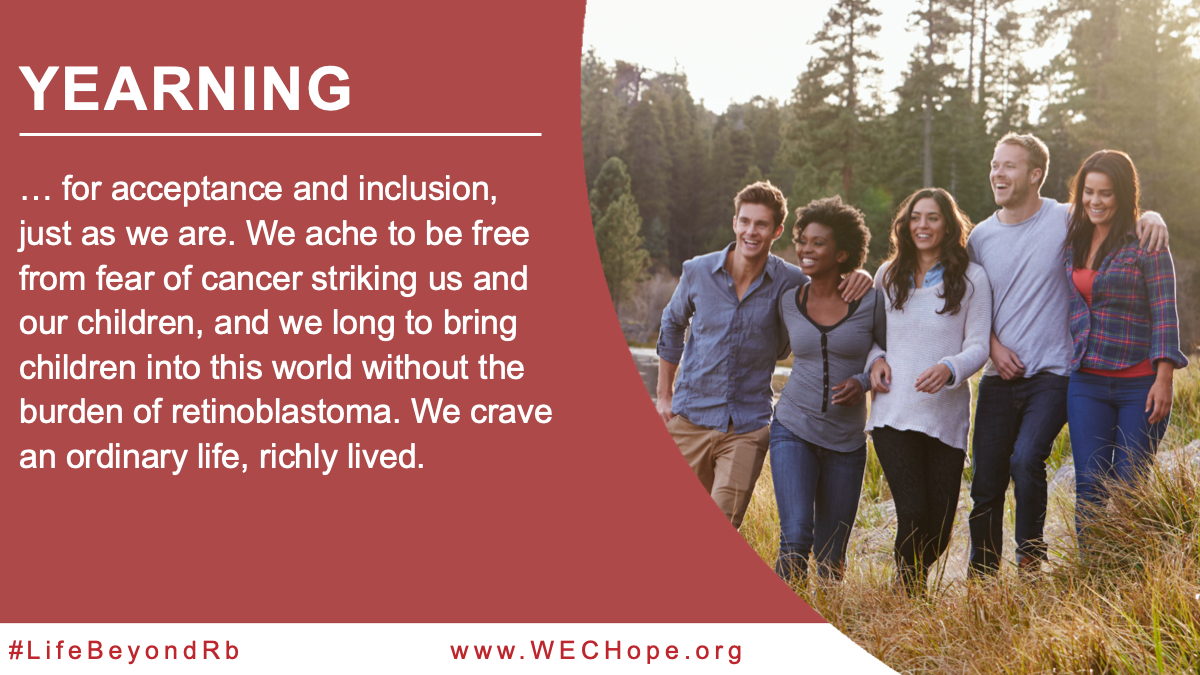Living with the Retinoblastoma Cancer Syndrome Part 2: Risks, Impacts, Challenges and Opportunities
Monday June 21, 2021
For individuals living with the retinoblastoma cancer syndrome, childhood eye cancer is only the start of the story. Sharing personal experience and insight from fellow Rb survivors, Abby White explores key challenges encountered along the way, from working with doctors who do not understand the risk to psychological impacts, and the need for more effective care.
Read Part 1: Understanding the Risks and Lifelong Care
I lost my brilliant father to a second cancer when he was 51 years old. A second cancer took his life, but the RB1 mutation caused that second cancer.
Retinoblastoma is highly curable, but RB1 kills survivors. It mauls and destroys our physical and psychological lives. Yet its damage could be reduced with lifelong care thoughtfully tailored to our unique needs.
In part one of this article, I reviewed the cancer risk and who it affects, the challenge of establishing personal risk, and provision of lifelong follow up care. Below, I highlight key concerns and needs we experience in accessing healthcare and living with this risk. I do so with the help of contributions from One Rb World 2012 and 2017, closed group and private discussions. All quotes are used with permission and gratitude.
Working with Doctors Unfamiliar with Retinoblastoma
Although long term follow up is recommended for individuals with an RB1 mutation, most children are discharged at 18 (or earlier) with no life-long follow up plan. Survivor clinics simply do not exist in many countries. This situation is compounded by primary doctors unfamiliar with treatment late effects and genetic implications of retinoblastoma.
Being aware of my increased cancer risk has developed a heightened awareness of my body, what is “normal” and what may be a cause for concern. I know that each newly identified ache, swelling or other anomaly may go away as silently as it emerged, but I also know it may be something sinister.
Keeping fear and worry in check drains a great deal of mental and emotional energy. Not so much because of the risk itself, but because I know there are better ways to manage my risk than constantly being on alert for any possible symptoms and scrambling to advocate for investigations.
Retinoblastoma oncologist Judith Kingston told me years ago to raise any unexplained symptom with my GP after two weeks; one week for unexplained neurological symptoms. My GP rarely hears of the issues that cause concern as I track them until they dissipate. I am on alert all the time – my life depends on it.
I am fortunate to have a very good GP who listens well, has learned about retinoblastoma risks over two decades of being my doctor, and takes my concerns seriously. This does reduce anxiety somewhat, but I frequently encounter gatekeepers to healthcare beyond my GP, who are not so aware. The friction generated at each stage of the process slows down investigations and life-impacting results.
Three years ago, I learned by chance that I have a meningioma, when I requested a copy of a recent MRI report for an independent medical facility. The brain tumour had been visible on three previous scans, remaining small and stable over four years. Even though the neurologist, ophthalmologist and ENT consultants who ordered those scans knew of my retinoblastoma, radiation and second cancer risk, none felt this was relevant information to share with either myself or my GP.
Had I developed symptoms, my GP would not have been able to advocate appropriately for me, even though she knows my RB1 risk, and I would not be able to advocate well for myself. One outcome of this experience is that I now no longer fully trust radiology reports delivered verbally by a physician. What has been deemed irrelevant, not worth telling? Key information about a benign tumour should never be withheld from a patient or parent, nor the primary care physician, when there is a cancer risk.
As the tumour has remained stable, neurosurgery recently proposed reducing MRI monitoring to every 2 or 3 years. Growth of this tumour threatens my remaining vision, as well as my sense of smell and taste, which are more precious when sight and hearing are already reduced, and even my personality. I politely requested that annual scans continue. I strongly feel this concern should have been obvious, and the change not proposed at all.
My risk is significantly greater than mere tumour growth. It is about my entire body and mind, my ability to be and feel, to connect and interact with the world, to remain independent, to confidently make decisions that shape my future, to LIVE.
Meningiomas are generally benign, but I know from too many friends in the retinoblastoma community that they can behave unexpectedly. Though dismissed as comparatively inoffensive when discussing second cancers, they often do very great harm in multiple ways to the individuals they affect. They are a common brain tumour after radiotherapy and need significantly more coordinated attention in retinoblastoma survivor research and care.
When we know our genetic status and risks, and our complete medical history, we can advocate for our own medical care, and we can educate our doctors when they are willing to learn from us. We can explain the need to avoid radiation exposure for routine imaging, and discuss alternative technologies such as MRI or ultrasound. We can discuss the importance of symptom awareness for both ourselves and our doctor.
However, most of us can tell stories of working with doctors who are unfamiliar with retinoblastoma’s lifelong impacts and risks, and unwilling to listen to our detailed knowledge of our own medical condition, or deep awareness of our own body. The results may be demoralizing and exhausting at best, and a death sentence at worst.
“I don’t have a regular GP. The practice I am registered with is large and it can be a month or more before an appointment is available for any of them. We’re told to raise any symptom concerns after two weeks, but how does that work in practicality if you can’t even see a GP within two weeks, let alone one who knows you well enough to understand your risks and take your concerns seriously? The follow up clinics seem to be more about late effects rather than addressing this ongoing cancer risk. I feel very vulnerable!”
“When I say I’ve been having x problem, doctors always ask if I’m on my period or around it, or any way I could be pregnant. Then it’s never addressed when I say no. I feel like doctors don’t validate our concerns. They don’t factor in that most of us always worry or think about having cancer again, the side effects of our treatment, how it affects our everyday lives and how emotionally tolling it is to have these things. Many doctors don’t realize how deep our diagnoses go.”
“I had Rb as a baby and have the RB1 mutation. I know my risks, but it seems I am the only one who does, other than my original doctors, who are retired. I have no follow-up, for ophthalmology or oncology. My GP doesn’t understand Rb or my mutation and thinks I am neurotic – she thinks I need to see a psychiatrist. I am so worried that one day the other shoe will drop and my diagnosis will come too late because no one is following me or paying attention to my risk.”
Letter B from our 2019 Alphabet of Hope – #LifeBeyondRb
When Family and Friends Develop Second Cancers
My father died two months after his cancer diagnosis. Shortly after he died, the retinoblastoma specialist who treated me told me the cancer had “nothing to do with retinoblastoma – it was just bad luck”. Failing to inform survivors fully of their risks is bad enough. Denying my family’s reality was hugely insulting, and caused unnecessary emotional pain.
I have lost so many friends over the years, to second cancers and their effects. Each time, I lose another part of myself, and the intensity of their absence from my life further exposes my own unattended risk.
My dearest friend, Ffion, died in January this year from the cumulative effects of retinoblastoma and two second primary cancers. In very different ways, we both experienced the sharp end of life with Rb through the last few years, and we were less available for one another. The guilt I feel about not being more present threatens sometimes to consume me. Several of our precious mutual friends continue to walk the most challenging of paths with second cancer.
Our tight-knit retinoblastoma family gives each of us vital strength and comfort as we travel this complicated lifelong journey. This community of survivorship is a like a delicate ballet – often we draw close, moving in step with one another in understanding support and joyful living, and sometimes our circle widens to create our own air when the experience becomes too potent. But we are always mindful of one another.
We embrace the friendship knowing we risk the heartbreak of another loss – perhaps the risk of loss deepens the connection. The constant mix of joy and sorrow, gratitude and grief is intense.
“My husband and son both have the RB1 mutation. I worry every time one of them gets a bruise, lump or ache they can’t explain – which is at least once a month. I know of course that not every ailment is cancer. My son is a rambunctious kid, my husband is blind in one eye. They knock themselves about every day, and the aches, pains and myriad other symptoms I lose sleep over could be any number of perfectly normal, boring and harmless things. But cancer is a real risk. If I take it for granted that they will be fine, I fear that one day cancer will bite too hard, and we may not recover.”
“I lost my wife to retinoblastoma. In practicality, to a second cancer, but effectively to retinoblastoma. I want the doctors to acknowledge this. Rb kills. Yes, it is second cancers, but it is the RB1 syndrome at the heart of the matter. Maybe if they acknowledge this fully, they will do more as a medical community to take closer care of survivors after the eye-focused treatment. Maybe they will understand how Rb impacts our families for life, that it never ends for those of us dealing with an RB1 mutation.”
“I was diagnosed with leiomyosarcoma a few months after an Rb friend was diagnosed with osteosarcoma. I felt so guilty that I worked all the way through radiotherapy while she was so sick with chemo, and she died anyway. She had a husband and beautiful child. When I hear about someone who has another cancer now, I feel such sadness and that it should have been me that died, not my friend. It’s hard. These are my people. It isn’t normal to lose friends like this.”
“When I joined the Rb community, I didn’t know anyone else with an artificial eye or the radiation issues or cancer risk, and it felt like finding my second family. But I’ve lost people from that family too, and that’s devastating, and sharpened the reality of my own risks. Probably it’s increased my cancer anxiety, but I’m also more educated, and more motivated by my friends’ experience to push for my own care. I know a few survivors whose Rb affected relatives choose not to be involved in the community. I envy them – lifelong Rb is intense and I want to shake it off. But on balance, for me, being connected is preferable.”
Retinoblastoma is Never Over
Some individuals do not like the term “survivor” to describe themselves and their cancer experience because it understates their ongoing risks.
Truly, we are all survivors. Survivors put one foot in front of the other with hope, even when life is tough. We give and receive courage and comfort, inspire and motivate one another. We treasure joy shared with family and friends, even as our knees rest in the dirt to pray for their healing, or grieve their loss. Most of all, we embrace life in big and small ways as our energies and capabilities allow in the moment.
But semantics are important. Eye cancer is only a small portion of the retinoblastoma story for individuals with an RB1 mutation. This is a cancer syndrome with lifelong threats and impacts.
Some individuals with ongoing risk never had retinoblastoma to become a survivor. How do we ensure they are included in the language we use, so they feel part of the community and are more likely to access the information and support they need to advocate for themselves?
“I am 24. My last Rb treatment was 19 years ago but I still say “I have retinoblastoma”. My son’s doctor tried to correct me when he heard me say this one time. He doesn’t understand. Sure, the cancer in my eyes is gone, but I have an artificial eye and poor sight in my other eye, and I live with long term and late effects of treatment every day. I don’t feel like a survivor yet. I’m still in the battle most days. I still live with retinoblastoma, it hasn’t left me. That’s why I say “I have retinoblastoma”. Please don’t belittle my struggles by trying to correct me or telling me I am wrong.”
“We found out I have the RB1 mutation after my son was diagnosed. I am not a survivor but I have the same cancer risks. Trying to explain that to people who only understand Rb as a linier journey from eye cancer through survivorship is hard. I am unseen.”
Letter Z from our 2019 Alphabet of Hope – #LifeBeyondRb
Translating Knowledge into Meaningful Care
For decades, retinoblastoma specialists and researchers have published articles clearly demonstrating the second cancer risk in carriers of RB1 mutation, especially survivors treated with radiotherapy. Yet there is still no consensus protocol to detect these pernicious cancers early. Without clear protocols that address our specific needs, survivors will continue to wrestle with fear and worry, allow risks to influence huge life decisions, battle for effective care, be diagnosed late with second cancers, and die far too young.
The outlook for those of us with lifelong risks from retinoblastoma very much depends on motivation of the retinoblastoma medical community to rewrite the future. Rb is rare, and second cancer risk rarer still. We need you who have expertise and passionate interest in this cancer syndrome to fight for us – your former patients, your survivors!
While radiotherapy is used rarely today, it was primary therapy until the 1990s, and continued to be widely used into the 2000s. Many adult survivors have ongoing radiation-increased risk that should not be dismissed with the shift in current treatment modalities for children with eye cancer.
Retinoblastoma is highly curable. Children diagnosed early and treated with appropriate care have excellent chance of growing into survivors. They, and we who walk ahead of them, need urgent and collaborative investment in survivorship care to ensure our lifelong risks and their impacts are effectively addressed. To guide the medical professionals who care for us, to support our complete physical, mental and emotional wellbeing for the best possible quality of life, and to give us the best chance of living a good long life.
“I get irritated by all the messaging that early diagnosis of retinoblastoma saves lives, while no effort is made to improve screening and early diagnosis for survivors with second cancer risk. The cancers may be less easy to spot, but they can still be found early. We matter just as much as the little children we once were, and we have families and loves and friends, and careers and adventures and dreams, and precious children of our own we passionately want to continue living for.”
“I had unilateral Rb. Genetic testing ensured my son’s early diagnosis and both his eyes were saved. I am so thankful, and firmly believe testing must be integral to patient care.
However, I am distressed by lack of investment in research to improve long-term outlook for survivors.
My vulnerability was exposed by recent removal of a benign tumor. Rb survivors are a close-knit global community thanks to the internet. We lose friends to second cancers every month; each loss mutilates our collective heart.
Surely science is at a point where prevention can become a reality? When will you recognize our life-long agony and help extend to us the same hope you have given to our children?”
Letter Y from our 2019 Alphabet of Hope – #LifeBeyondRb
About the Author
Abby’s father was diagnosed with bilateral retinoblastoma in Kenya in 1946. Abby was also born with cancer in both eyes. She has an artificial eye and limited vision in her left eye that is now failing due to late effects of radiotherapy in infancy.
Abby studied geography at university, with emphasis on development in sub-Saharan Africa. She co-founded WE C Hope with Brenda Gallie, responding to the needs of one child and the desire to help many in developing countries. After receiving many requests for help from American families and adult survivors, she co-founded the US chapter to bring hope and encourage action across the country.
Abby enjoys listening to audio books, creative writing, open water swimming and long country walks.








Leave a Reply
Want to join the discussion?Feel free to contribute!